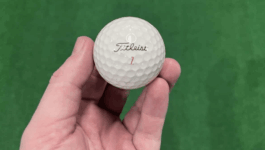When it comes down to the selection of wedges to carry in the bag, an unwritten rule is to allow 4 to 5- degrees between each wedge. So if the pitching wedge is at 46-degrees, then a gap wedge could be added in between the pitching and the sand wedge.
A sand Wedge of 56 to 58-degrees is a universal wedge that can be used for bunker play and also for those tricky shots over traps or water to tight pin placement.
Using these numbers, to cover the gap between the pitching and sand wedge, it then suggests a gap wedge of 50 to 52-degrees. This however is a guideline for golfers and any beginner to the game should not stress too much about a degree here and there between wedges.
Lob Wedge
Generally, lob wedges carry 60-degrees of loft and are used to recover from difficult positions near the green. However, in my opinion, a beginner should shy away from a lob wedge, as it is a finesse club and requires skill and many, many hours of practice, to hit with confidence.
The short game is all about confidence and therefore an area any beginner should spend time practicing. Below are a few good reasons for a beginner to keep a lob wedge out of the bag:
- It is the most lofted club in the set, and judging the distance it will fly after contact will take practice.
- Lob wedges have large soles which tend to dig into lush or wet turf conditions.
- They have the most “bounce” and from tight fairways or lies, will skid into the center of the ball which will fly low right across the green.
- 90% of beginner golfers will leave the approach shot short of the intended distance required on the shot.
- They require good lies on the fairway or rough in order for the clubhead to slide easily under the ball to create spin.
- Will the beginner be competent enough to make this call?
Pitching Wedge
Pitching wedges can vary in degrees of loft, depending on the manufacturer. Modern-day wedges tend to be stronger, with less loft than the older model wedges that would carry up to 48-degrees of loft. The tendency in the latest models is to de-loft most of the set to hit the ball further with each club. Unfortunately, distance does not always equate to good scores.
Gap Wedge
As the name suggests, it is a wedge that fills the gap between the pitching wedge and the sand wedge. As discussed previously, the aim is to have no more than 4 to 5-degrees of loft difference. These clubs will have a slightly thicker sole, and ease through good turf conditions. The difficulty is establishing how far the beginner can hit the ball with the gap wedge.
Sand Wedge
The sand wedge is a must club to carry in the bag and is primarily designed to get the ball out of sand bunkers, or traps as they are commonly referred to. The degree of loft can vary from 54 to 58-degrees. Selecting the right sand wedge is very important for the beginner golfer, as this shot is the only one on the course, where you deliberately aim to hit behind the ball. There are various ways to play out of the traps, which we will discuss later.
Matching Wedges To The Set
Manufacturers continually “tweak” club lofts to increase the distance the ball will travel, through the set. With this understanding, a ping pitching wedge will not carry the same loft as a cleveland pitching wedge, so trying to correlate the two, is not the solution.
Sets all come with a pitching wedge, but not with a gap wedge, or even a sand wedge. Determining the lofts on the wedge and sand wedge will assist in the purchase of the gap wedge.
What is 1-degree of loft in terms of distance?
One degree of loft equates to approx 1,8 meters in distance. This may not sound important to the beginner golfer, but in time they will understand how important it is to know exactly how far they hit each club in the bag. We discussed the gaps between lofts required to fit the Wedges together to match the iron set.
What Distance will a 46-degree Pitching Wedge Fly?
On average the 46-degree pitching wedge will fly approx 108 meters. It all depends on the skill of the player and the swing speed. For the beginner, it is an easy exercise to determine. Go to the range and hit 10 golf balls with the wedge. Now pace off the distance to a few balls that have come to rest fairly close to each other. This is not an exact science but will give an indication of the average distance the beginner can expect to hit the ball with the pitching wedge. Knowing this distance just made selecting wedges for the set much simpler.
Calculating distances between Clubs for the Beginner
Knowing the distance the beginner hits each club is a worthwhile exercise and will make the game easier and more enjoyable. Use anything from 6 to 9 meters per club, depending on the skill level attained. Knowing the average swing speed with irons can be useful and can be measured by any teaching pro or retail golf outlet. As the beginner progresses, these stats will become invaluable and will lower scores.
Should a Gap Wedge be added to the Set for a Beginner?
Earlier in this article, we discussed the merits of adding a lob wedge to the set for a beginner. This can also apply to the gap wedge. The pitching wedge is a “dynamic” club in the correct hands and developing the skill level will quickly bring down scores over 18-holes. It can be used to chip from just off the green or play short pitch shots of 15-meters to 80-meters from the green. Adding additional clubs to the beginner’s bag can just confuse the player, by offering too many options.
How to Play the Sand Wedge from a Bunker?
Developing this skill is paramount for the beginner to improve scores and enjoyment on the course. How many times have you witnessed a playing partner “thrashing” at the ball a few times in the trap, but never comes out? Then pick it up fuming!! Most beginners “freeze” on the shot, which exacerbates the issue.
There are a few basic fundamentals to bunker play:
- Move your feet in the sand to feel the texture of the sand.
- Open the stance with the intention of hitting the ball from the outside in swing plane.
- Play the ball forward in the stance.
- Pick a spot in the sand about a 2-inches behind the ball where you want to make contact with the sand.
- Most Importantly, follow through with the clubhead coming out of the sand after the shot.
- Remember it is the only shot that you intentionally hit behind the ball.
- The lack of follow-through is the major cause of bad bunker play.
Using the Sand Wedge off the Fairway or from the Rough
Remember this club has the most bounce in the set and requires clean contact with the ball, or it will be “gummed” and fly low and far. From the rough, it is a good club for extricating the ball from a bad lie. If the lie is not good from either, then elect to play a chip and roll shot, especially on approaches to an open green. Set the hands in front of the ball and hit down and through the shot for best results. The ball can be played slightly further back in the stance.
How to Play the Pitching Wedge?
This is a “scoring” club and mastering the art of playing it from all kinds of lies and difficult positions, is a score saver. This is the club that can replace the gap wedge for the beginner and should become a favorite in the bag. Play the ball from the center or slightly back of center in the stance, and always hit down on the ball, for spin and control. It requires finesse and can be played from any distance within the beginner’s range. Learn to play half shots, by gripping down on the grip and swinging easily from all different lengths of the backswing. Get good with this club and watch your scores tumble!
Final Thoughts
My suggestion to beginners is to find a set of clubs that match your swing speed and take care to ensure the correct shaft is fitted. Check the degrees of loft on the pitching wedge, and if a sand wedge is not included, then go for a minimum of 56 or 58-degree club. Consider the texture of the sand at your home club, before your selection. Now you have the tools to play better golf and the gap wedge can be added later to the set. The last wedge to add is the lob wedge, but be warned, this can be a score wrecker! 2 wedges is a good call.
Related Articles
- 7 of The Best Golf Wedges
- Pitch Shot vs Chip Shot
- Buying Golf Club Sets; A Guide To The Best Beginners Golf Club Sets
- Top Wedges For High Handicappers
Nick is the founder of GolfSpan and an avid golfer. He's not quite a pro but has over 15 years of experience playing and coaching golfers worldwide. His mission is to bring the golfing community a better experience when it comes to choosing the right golf gear and finding the right setup for your game.






